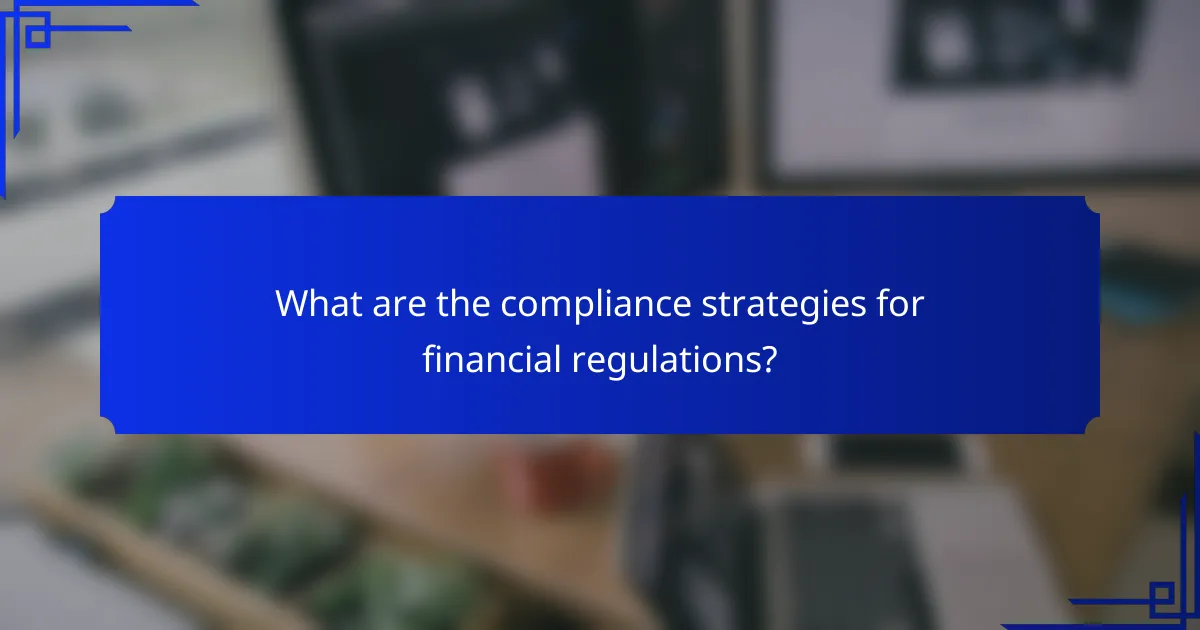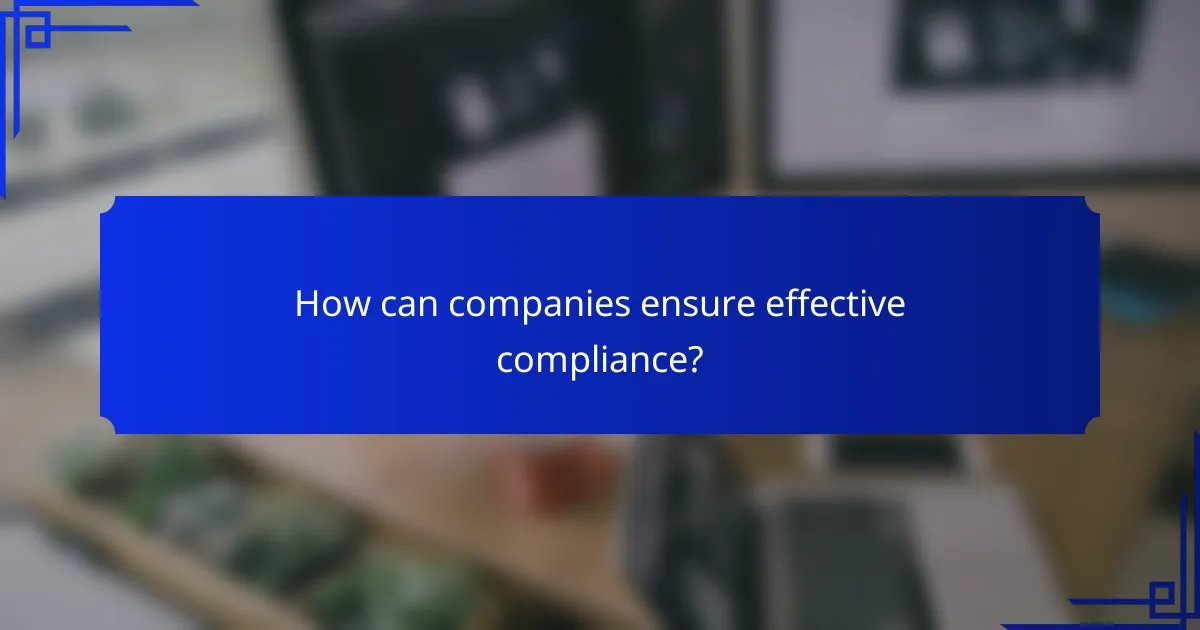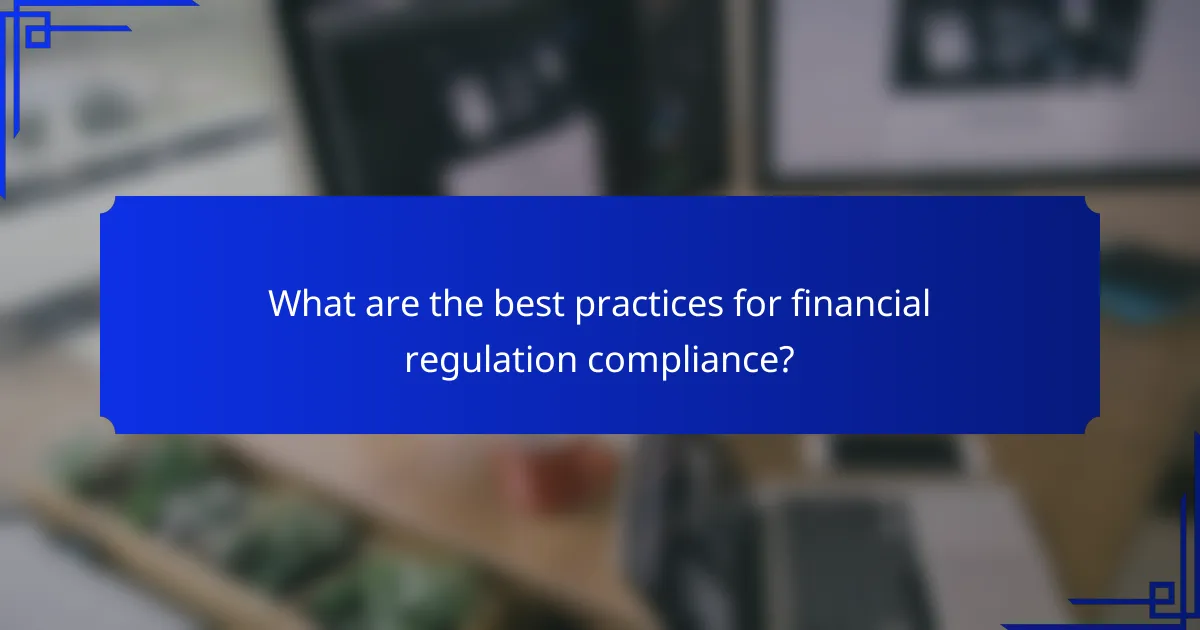In the realm of financial regulations, compliance strategies are essential for organizations to navigate the complexities of legal requirements effectively. These strategies involve comprehensive risk assessments, internal audits, and employee training, all aimed at mitigating risks and enhancing compliance. However, companies face significant challenges such as evolving regulations and resource constraints, making it crucial to adopt systematic approaches to ensure adherence and avoid penalties.

What are the compliance strategies for financial regulations?
Compliance strategies for financial regulations involve structured approaches to ensure adherence to legal and regulatory requirements. These strategies typically encompass risk assessments, internal audits, employee training, technology integration, and vendor management to mitigate risks and enhance compliance effectiveness.
Risk assessment frameworks
Risk assessment frameworks help organizations identify, evaluate, and prioritize risks associated with financial regulations. By systematically analyzing potential threats, companies can develop strategies to address vulnerabilities and allocate resources effectively.
Common frameworks include the COSO framework and ISO 31000, which provide guidelines for risk management processes. Regularly updating these assessments ensures that organizations remain compliant as regulations evolve.
Internal audit processes
Internal audit processes are essential for evaluating the effectiveness of compliance strategies. These audits assess whether financial practices align with regulatory requirements and internal policies, identifying areas for improvement.
Implementing a regular audit schedule and involving cross-functional teams can enhance the audit’s effectiveness. Organizations should also establish clear reporting mechanisms to address findings promptly.
Employee training programs
Employee training programs are crucial for fostering a culture of compliance within financial institutions. These programs should cover relevant regulations, company policies, and ethical standards to ensure all employees understand their responsibilities.
Training should be ongoing and tailored to different roles within the organization. Utilizing interactive methods, such as workshops and e-learning modules, can improve engagement and retention of compliance knowledge.
Technology integration
Technology integration streamlines compliance processes by automating routine tasks and enhancing data management. Tools such as compliance management software can help track regulatory changes and facilitate reporting.
When selecting technology solutions, organizations should consider scalability and user-friendliness. Regular updates and training on these tools are essential to maximize their effectiveness in maintaining compliance.
Third-party vendor management
Third-party vendor management is vital for ensuring that external partners comply with financial regulations. Organizations should conduct thorough due diligence before engaging vendors and establish clear compliance expectations in contracts.
Regular monitoring and assessments of vendors’ compliance practices can mitigate risks associated with outsourcing. Developing a vendor risk management framework helps maintain oversight and accountability in the supply chain.

What challenges do organizations face in financial regulation compliance?
Organizations encounter several significant challenges in financial regulation compliance, including the complexity of regulations, resource allocation issues, data privacy concerns, and rapid regulatory changes. These factors can complicate compliance efforts and increase the risk of non-compliance, which can lead to financial penalties and reputational damage.
Complexity of regulations
The complexity of financial regulations can be overwhelming for organizations, as they often involve intricate legal language and numerous stipulations. Companies must navigate a myriad of local and international laws, which can vary widely across jurisdictions. Understanding and implementing these regulations requires specialized knowledge and can lead to compliance gaps if not managed properly.
To address this complexity, organizations should invest in compliance training for staff and consider hiring compliance experts. Regular audits can also help identify areas of misunderstanding or misapplication of regulations.
Resource allocation issues
Many organizations struggle with resource allocation when it comes to compliance efforts. Limited budgets and personnel can hinder the ability to implement effective compliance programs. This often results in inadequate monitoring and reporting systems, which can increase the risk of non-compliance.
To optimize resource allocation, organizations should prioritize compliance activities based on risk assessments. Leveraging technology, such as compliance management software, can also help streamline processes and reduce the burden on human resources.
Data privacy concerns
Data privacy is a critical concern for organizations in the context of financial regulation compliance. With regulations like the General Data Protection Regulation (GDPR) in Europe and various local laws, companies must ensure that they handle sensitive customer information appropriately. Failure to comply can result in hefty fines and loss of customer trust.
Organizations should implement robust data protection policies and conduct regular training for employees on data handling practices. Additionally, establishing clear protocols for data access and sharing can help mitigate privacy risks.
Rapid regulatory changes
The financial regulatory landscape is constantly evolving, which poses a challenge for organizations striving to stay compliant. Rapid changes can stem from new legislation, shifts in government policy, or emerging industry standards. Keeping up with these changes requires ongoing vigilance and adaptability.
To manage rapid regulatory changes, organizations should establish a dedicated compliance team that monitors regulatory developments. Regularly updating compliance policies and engaging with industry groups can also provide insights into upcoming changes and best practices.

How can companies ensure effective compliance?
Companies can ensure effective compliance by implementing systematic strategies that include regular audits, utilizing specialized software, and engaging legal experts. These approaches help identify gaps, streamline processes, and ensure adherence to applicable regulations.
Regular compliance audits
Conducting regular compliance audits is essential for identifying potential risks and ensuring adherence to regulations. These audits should be scheduled at least annually, but semi-annual or quarterly audits can provide more frequent oversight.
During an audit, companies should assess their policies, procedures, and controls against regulatory requirements. This can include reviewing financial records, employee training programs, and operational processes to ensure they align with industry standards.
Utilizing compliance software
Compliance software can significantly enhance a company’s ability to manage regulatory requirements efficiently. These tools often include features for tracking changes in regulations, automating reporting, and facilitating employee training.
When selecting compliance software, companies should consider factors such as user-friendliness, integration capabilities with existing systems, and the ability to customize reports. Investing in a robust solution can save time and reduce the risk of non-compliance.
Engaging legal experts
Engaging legal experts is crucial for navigating complex regulatory landscapes. These professionals can provide tailored advice on compliance strategies and help interpret regulations relevant to the business’s operations.
Companies should consider retaining legal counsel with experience in their specific industry, as this expertise can lead to more effective compliance measures. Regular consultations can also help businesses stay ahead of regulatory changes and avoid costly penalties.

What are the best practices for financial regulation compliance?
The best practices for financial regulation compliance involve creating a proactive approach that integrates compliance into the organizational culture, ensures ongoing monitoring, and maintains clear communication. These strategies help organizations navigate complex regulations while minimizing risks and enhancing operational efficiency.
Establishing a compliance culture
Establishing a compliance culture means embedding regulatory adherence into the core values of the organization. This can be achieved by providing regular training to employees at all levels, emphasizing the importance of compliance in daily operations. Leadership should model compliance behaviors to reinforce this culture.
Organizations can implement a code of conduct that outlines compliance expectations and encourages ethical behavior. Regular assessments and feedback mechanisms can help identify areas for improvement and ensure that compliance remains a priority.
Continuous monitoring and reporting
Continuous monitoring and reporting are essential for maintaining compliance with financial regulations. This involves regularly reviewing processes and transactions to identify potential compliance issues before they escalate. Automated systems can aid in tracking compliance metrics and flagging anomalies for further investigation.
Organizations should establish a reporting framework that allows for timely communication of compliance status to relevant stakeholders. This may include monthly compliance reports that summarize findings and outline corrective actions taken to address any identified gaps.
Clear communication channels
Clear communication channels facilitate effective compliance by ensuring that all employees understand their roles and responsibilities regarding regulatory adherence. Organizations should establish formal lines of communication for reporting compliance concerns or breaches without fear of retaliation.
Regular meetings and updates can help keep compliance top-of-mind, while digital platforms can provide accessible resources and guidelines. Encouraging open dialogue about compliance issues fosters a transparent environment where employees feel empowered to contribute to the organization’s regulatory efforts.

How do financial regulations differ across regions?
Financial regulations vary significantly across regions due to differing legal frameworks, economic conditions, and cultural factors. These differences can impact compliance strategies and the overall regulatory landscape for businesses operating internationally.
US vs EU regulations
The United States and the European Union have distinct regulatory environments that affect financial institutions. In the US, regulations are often more fragmented, with multiple agencies like the SEC and the CFTC overseeing different aspects of the financial markets. In contrast, the EU typically employs a more unified approach through directives and regulations that apply across member states.
For example, the Dodd-Frank Act in the US focuses on consumer protection and systemic risk, while the EU’s MiFID II aims to enhance transparency and investor protection. Companies operating in both regions must navigate these complexities to ensure compliance.
Regulatory bodies comparison
In the US, key regulatory bodies include the Securities and Exchange Commission (SEC), the Commodity Futures Trading Commission (CFTC), and the Federal Reserve. Each agency has specific mandates, which can lead to overlapping jurisdictions and compliance challenges for firms.
Conversely, the EU’s regulatory framework is overseen by bodies such as the European Securities and Markets Authority (ESMA) and the European Central Bank (ECB). These organizations work to harmonize regulations across member states, which can simplify compliance for businesses operating within the EU.
Understanding the roles and responsibilities of these regulatory bodies is crucial for firms to develop effective compliance strategies and avoid potential pitfalls in both regions.

What role does technology play in compliance?
Technology plays a crucial role in compliance by automating processes, enhancing data accuracy, and facilitating real-time reporting. It helps organizations manage regulatory requirements more efficiently and reduces the risk of human error.
Automation of Compliance Processes
Automation streamlines compliance tasks, such as data collection and reporting, allowing organizations to focus on strategic initiatives. By using software solutions, companies can ensure that compliance checks are performed consistently and on time.
For example, automated systems can generate reports that align with regulatory standards, significantly reducing the time spent on manual data entry. This not only improves efficiency but also enhances the reliability of the information provided to regulators.
Data Management and Analytics
Effective data management is essential for compliance, and technology enables organizations to collect, store, and analyze large volumes of data. Advanced analytics tools can identify trends and anomalies that may indicate compliance risks.
Organizations can leverage data analytics to monitor compliance metrics continuously, allowing for proactive risk management. For instance, financial institutions often use analytics to detect suspicious transactions that could signal money laundering.
Real-Time Monitoring and Reporting
Real-time monitoring tools provide organizations with immediate insights into their compliance status, enabling swift action when issues arise. These tools can alert compliance teams to potential violations as they occur, rather than after the fact.
For example, a company might implement a dashboard that tracks compliance indicators, such as transaction volumes or regulatory changes. This allows for timely adjustments to compliance strategies, ensuring adherence to evolving regulations.
Challenges in Implementing Technology for Compliance
While technology offers significant benefits for compliance, challenges exist, including integration with existing systems and ensuring data security. Organizations must carefully evaluate their technology solutions to avoid disruptions.
Additionally, the rapid pace of technological change can make it difficult for compliance teams to stay updated on the latest tools and best practices. Regular training and investment in technology upgrades are essential to overcome these challenges.
Best Practices for Leveraging Technology in Compliance
To effectively leverage technology for compliance, organizations should adopt a strategic approach that includes thorough planning and stakeholder engagement. Establishing clear objectives and aligning technology with compliance goals is crucial.
Regular audits of technology systems can help identify gaps and areas for improvement. Companies should also foster a culture of compliance, encouraging employees to embrace technology as a tool for enhancing compliance efforts.
